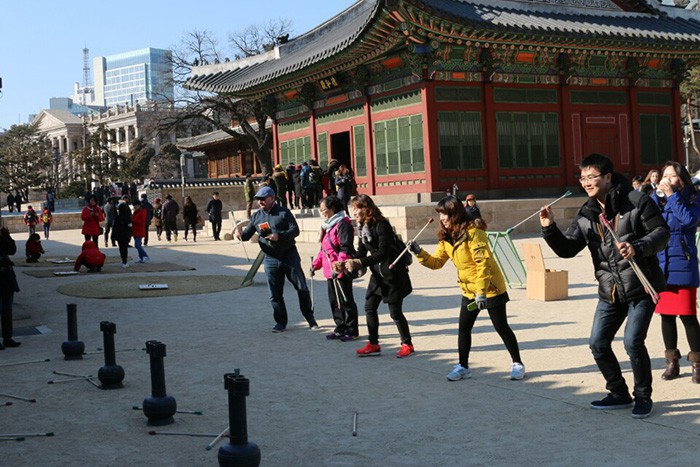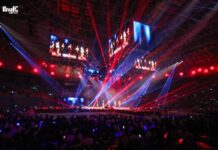
Visitors wearing Hanbok play the yunnori board game (윷놀이) at Gyeongbokgung Palace.
Seollal Lunar New Year’s, one of the biggest holidays in Korea, is just around the corner.
Visiting a palace or a national museum and enjoying the nation’s traditional activities would be a wonderful way to spend the holidays with family and friends during the upcoming four-day vacation spanning Friday, Jan. 27, to Monday, Jan. 30.
The national museums will be open for three days during the holiday, not on Jan. 28, the Seollal Lunar New Year’s Day itself. All the national museums will also be hosting a wide range of special Seollal events for holiday visitors.
The National Museum of Korea in Seoul will present namsadang nori performances (남사당놀이), a series of music and circus performance in its main open-air atrium. The permanent exhibitions will be closed on Jan. 28, but the special exhibition “Egyptian Treasures from the Brooklyn Museum” will be open that day.

The National Museum of Korea in Seoul will host a series of traditional namsadang nori music and circus performances (남사당놀이) in its open-air atrium on Jan. 28.
The Gyeongju National Museum in Gyeongsangbuk-do Province will provide performances for family visitors, such as a samulnori percussion show (사물놀이), a mask dance, a magic show and a bubble show. Traditional activities, such as beating rice dough with a large wooden mallet, making traditional foods such as injeolmi rice cake (인절미), traditional dasik pressed sweets (다식), tteokguk rice cake soup (떡국), and playing traditional games will also be available.

Visitors to the Gyeongju National Museum beat rice dough with a wooden mallet, one of the traditional practices of the Seollal Lunar New Year’s holidays.
The Chuncheon National Museum in Gangwon-do Province will also host a range of traditional events involving games and food. On Jan. 27 and 29, a traditional Korean calligrapher will hand-write traditional family mottos for guests.
Traditional games, like making a norigae pendant (노리개) and a samulnori performance, will also be available at the Gimhae National Museum in Gyeongsangnam-do Province.
The Cheongju National Museum in Chungcheongbuk-do Province will give out chicken-shaped piggy banks to children to celebrate the year of the red rooster. Classical music performances and a children’s musical will take place on Jan. 29 and 30.
At the Gwangju National Museum, visitors will be able to print their own bujeok good luck charm (부적).
Traditional events are also scheduled for the nation’s palaces and royal tombs.
On Seollal Lunar New Year’s Day, Jan. 28, Gyeongbokgung Palace, Changdeokgung Palace, Changgyeonggung Palace, Deoksugung Palace, the Jongmyo Shrine and the tombs of Joseon kings will be open to the public free of charge. Many of them are normally closed on Mondays, but Monday, Jan. 30, will be an exception and they will all be open. Also, the Jongmyo Shrine, which only accepts visitors who made a reservation, will be open to all during the four-day holiday.
Gyeongbokgung Palace is opening the Jipgyeongdang Hall on Jan. 28 and 29 so that tourists will be able to give a sebae deep bow (세배) to their elders while kneeling in an ondolbang under-floor heated (온돌방) ceremony room.
The National Folk Museum of Korea near the palace is open on all four days of the holiday and will provide traditional experiences for visitors.
The National Palace Museum of Korea, another nearby museum, will hold a pansori musical performance based on the classical Korean novel “Simcheongjeon.”
Traditional games are also available at Deoksugung Palace, the Yeongneung Royal Tomb in Yeoju, Gyeonggi-do Province, the Hyeonchungsa Shrine (현충사) and at the Tomb of the Seven Hundred Patriotic Martyrs in Geumsan (금산 칠백의총).
By Kim Young Shin
Korea.net Staff Writer
Photos: Cultural Heritage Administration, National Museum of Korea, Gyeongju National Museum
ysk1111@korea.kr

Families can enter the Jipgyeongdang Hall at Gyeongbokgung Palace to perform a sebae deep bow (세배) in an ondolbang (온돌방) under-floor heated room.

Traditional games, such as the tuho arrow-throwing game (투호) and the yunnori board game, are available to visitors at palaces and museums around the country during the Seollal Lunar New Year’s holidays.























